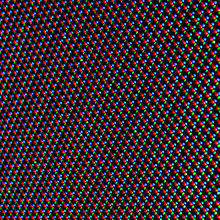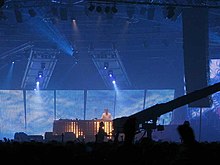
An organic light-emitting diode (OLED), also known as organic electroluminescentdiode, is a type of light-emitting diode (LED) in which the emissive electroluminescent layer is an organic compound film that emits light in response to an electric current. This organic layer is situated between two electrodes; typically, at least one of these electrodes is transparent. OLEDs are used to create digital displays in devices such as television screens, computer monitors, and portable systems such as smartphones and handheld game consoles. A major area of research is the development of white OLED devices for use in solid-state lighting applications.

A flat-panel display (FPD) is an electronic display used to display visual content such as text or images. It is present in consumer, medical, transportation, and industrial equipment.

A display device is an output device for presentation of information in visual or tactile form. When the input information that is supplied has an electrical signal the display is called an electronic display.

A field-emission display (FED) is a flat panel display technology that uses large-area field electron emission sources to provide electrons that strike colored phosphor to produce a color image. In a general sense, an FED consists of a matrix of cathode ray tubes, each tube producing a single sub-pixel, grouped in threes to form red-green-blue (RGB) pixels. FEDs combine the advantages of CRTs, namely their high contrast levels and very fast response times, with the packaging advantages of LCD and other flat-panel technologies. They also offer the possibility of requiring less power, about half that of an LCD system. FEDs can also be made transparent.

A flexible organic light-emitting diode (FOLED) is a type of organic light-emitting diode (OLED) incorporating a flexible plastic substrate on which the electroluminescent organic semiconductor is deposited. This enables the device to be bent or rolled while still operating. Currently the focus of research in industrial and academic groups, flexible OLEDs form one method of fabricating a rollable display.
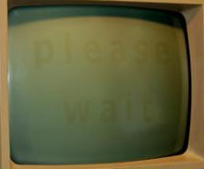
Screen burn-in, image burn-in, ghost image, or shadow image, is a permanent discoloration of areas on an electronic display such as a cathode ray tube (CRT) in an old computer monitor or television set. It is caused by cumulative non-uniform use of the screen.

In electronics, an LED circuit or LED driver is an electrical circuit used to power a light-emitting diode (LED). The circuit must provide sufficient current to light the LED at the required brightness, but must limit the current to prevent damaging the LED. The voltage drop across an LED is approximately constant over a wide range of operating current; therefore, a small increase in applied voltage greatly increases the current. Very simple circuits are used for low-power indicator LEDs. More complex, current source circuits are required when driving high-power LEDs for illumination to achieve correct current regulation.
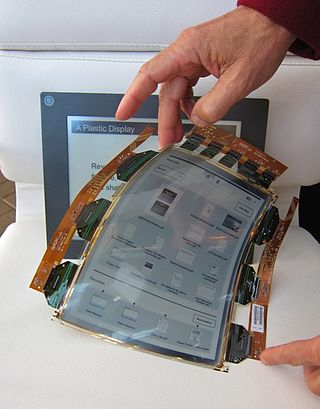
A flexible display or rollable display is an electronic visual display which is flexible in nature, as opposed to the traditional flat screen displays used in most electronic devices. In recent years there has been a growing interest from numerous consumer electronics manufacturers to apply this display technology in e-readers, mobile phones and other consumer electronics. Such screens can be rolled up like a scroll without the image or text being distorted. Technologies involved in building a rollable display include electronic ink, Gyricon, Organic LCD, and OLED.
Laser color television, or laser color video display, is a type of television that utilizes two or more individually modulated optical (laser) rays of different colors to produce a combined spot that is scanned and projected across the image plane by a polygon-mirror system or less effectively by optoelectronic means to produce a color-television display. The systems work either by scanning the entire picture a dot at a time and modulating the laser directly at high frequency, much like the electron beams in a cathode ray tube, or by optically spreading and then modulating the laser and scanning a line at a time, the line itself being modulated in much the same way as with digital light processing (DLP).
Display motion blur, also called HDTV blur and LCD motion blur, refers to several visual artifacts that are frequently found on modern consumer high-definition television sets and flat panel displays for computers.
An electronic visual display is a display device that can display images, video, or text that is transmitted electronically. Electronic visual displays include television sets, computer monitors, and digital signage. They are ubiquitous in mobile computing applications like tablet computers, smartphones, and information appliances. Many electronic visual displays are informally referred to as screens.
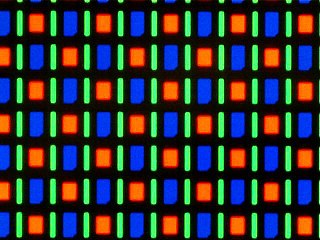
AMOLED is a type of OLED display device technology. OLED describes a specific type of thin-film-display technology in which organic compounds form the electroluminescent material, and active matrix refers to the technology behind the addressing of pixels.
Digital newspaper technology is the technology used to create or distribute a digital newspaper.

Steven Van Slyke is an American chemist, best known for his co-invention of the Organic Light Emitting Diode (OLED) and his contributions to the commercial development of OLED displays. Van Slyke is currently the Chief Technology Officer Emeritus at Kateeva, Inc. Prior to joining Kateeva, he held various positions at Eastman Kodak and was involved in all aspects of OLED technology, from basic materials development to implementation of full-color OLED display manufacturing.
Electrically operated display devices have developed from electromechanical systems for display of text, up to all-electronic devices capable of full-motion 3D color graphic displays. Electromagnetic devices, using a solenoid coil to control a visible flag or flap, were the earliest type, and were used for text displays such as stock market prices and arrival/departure display times. The cathode ray tube was the workhorse of text and video display technology for several decades until being displaced by plasma, liquid crystal (LCD), and solid-state devices such as thin-film transistors (TFTs), LEDs and OLEDs. With the advent of metal–oxide–semiconductor field-effect transistors (MOSFETs), integrated circuit (IC) chips, microprocessors, and microelectronic devices, many more individual picture elements ("pixels") could be incorporated into one display device, allowing graphic displays and video.

A quantum dot display is a display device that uses quantum dots (QD), semiconductor nanocrystals which can produce pure monochromatic red, green, and blue light. Photo-emissive quantum dot particles are used in LCD backlights or display color filters. Quantum dots are excited by the blue light from the display panel to emit pure basic colors, which reduces light losses and color crosstalk in color filters, improving display brightness and color gamut. Light travels through QD layer film and traditional RGB filters made from color pigments, or through QD filters with red/green QD color converters and blue passthrough. Although the QD color filter technology is primarily used in LED-backlit LCDs, it is applicable to other display technologies which use color filters, such as blue/UV active-matrix organic light-emitting diode (AMOLED) or QNED/MicroLED display panels. LED-backlit LCDs are the main application of photo-emissive quantum dots, though blue OLED panels with QD color filters are being researched.
Universal Display Corporation is a developer and manufacturer of organic light emitting diodes (OLED) technologies and materials as well as provider of services to the display and lighting industries. It is also an OLED research company. Founded in 1994, the company currently owns or has exclusive, co-exclusive or sole license rights with respect to more than 3,000 issued and pending patents worldwide for the commercialization of phosphorescent based OLEDs and also flexible, transparent and stacked OLEDs - for both display and lighting applications. Its phosphorescent OLED technologies and materials are licensed and supplied to companies such as Samsung, LG, AU Optronics CMEL, Pioneer, Panasonic Idemitsu OLED lighting and Konica Minolta.

A see-through display or transparent display is an electronic display that allows the user to see what is shown on the screen while still being able to see through it. The main applications of this type of display are in head-up displays, augmented reality systems, digital signage, and general large-scale spatial light modulation. They should be distinguished from image-combination systems which achieve visually similar effects by optically combining multiple images in the field of view. Transparent displays embed the active matrix of the display in the field of view, which generally allows them to be more compact than combination-based systems.
Crystal LED (CLED) refers to a screen manufacturing technique. It was invented by Sony and revealed at CES 2012.

MicroLED, also known as micro-LED, mLED or μLED is an emerging flat-panel display technology consisting of arrays of microscopic LEDs forming the individual pixel elements. Inorganic semiconductor microLED (μLED) technology was first invented in 2000 by the research group of Hongxing Jiang and Jingyu Lin of Texas Tech University while they were at Kansas State University. The first high-resolution and video-capable InGaN microLED microdisplay in VGA format was realized in 2009 by Hongxing Jiang and Jingyu Lin and their colleagues at Texas Tech University and III-N Technology, Inc. via active driving of microLED array by a complementary metal-oxide semiconductor (CMOS) IC. Compared to widespread LCD technology, microLED displays offer better contrast, response times, and energy efficiency.
